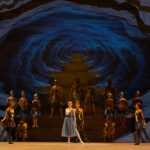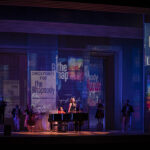
Elation is Moving from Concerts and Nightclubs to the Theatrical Stage
How do you develop a line of lighting products that work for the particular needs of theater? If you are Elation Professional, you ask theatrical lighting designers directly what they need, what they want and you take those answers into product development. Three theatrical lighting designers — Alex Jainchill, Jason Lyons and Justin Townsend — are among the LDs that have found the Elation line offers fixtures with the features they are looking for in theatrical lighting tools. Along with speaking with all three, I also spoke with Elation’s director of sales, Eric Loader, and national sales manager, John Dunn, to discuss the company’s focused approach to responding to the needs of theater lighting designers.
Listen and Learn
Much of the work that Dunn does when interfacing with theatrical lighting designers is listening. Listening to their needs and what tools they need for their work. “Mostly, what we do, is that we ask them what they want,” says Dunn. “That’s where I start. I try to find out what they wish they could do, things that the more established theater market lights don’t offer them. We’re a younger company with a fresher look at how things could be done. I’ve been particularly excited about working with the theater market because I find that a lot of the LDs are looking for something different. It’s a collaborative effort on how we can help them accomplish what they’re trying to get to without any limitation; at Elation we think about product development in a different way. Plus, our development process is rapid, so we are responsive to what the feedback is from the designers.”
Elation knows that a one-size-fits-all approach does not work in theater; from listening, they have been able to address the market specifically. “Our products reflect what we learn listening to the designers. Yes, as a company, we have a vast product offering,” says Dunn. “There’s a reason for that approach; we want to address market segments in an effective manner. You can’t just tell people, ‘We’re launching this one product right now and we think it fits all your needs.’ That’s not how we approach things at Elation.”
“We know that Elation has had a history of being a manufacturer with a focus on concerts/clubs; that’s where we started, but we have grown into other markets now,” notes Loader. “We’ve come to realize that the theatrical market has very unique needs, demands and requirements; we’re now focused on implementing solutions for those needs. With our Artiste series, we aimed towards the theatrical market. We also see that the theatrical-grade fixtures being designed by Elation not only work well in the theater market, but will transcend to all production including broadcasts and concerts as well.”
One of the biggest issues of incorporating automated lighting into theater is to limit the noise as much as possible. As more automated and electronic products get used in theater, the noise floor keeps increasing, but the tolerance is still very, very low for adding noise from lighting units. “This is one of the areas that Elation has been focused,” comments Loader. “Learning what the theatrical designers want has been a process for us. We are definitely focused on two areas — optics, and the quietness of the fixture. Not only the fan noise that it makes, but also on mechanical noise, how quiet is it when it changes color, when the iris, zoom, focus and other elements move together. Keeping the noise level way down and the optics high quality. I think that we’ve excelled in these areas in the last few years.”
Dunn points out, “I think that when we started adding in UV LED chips; when we went from four color to six color mixing, we really got the attention of a lot of the theater designers. When we added the UV and the amber chips, we really added another dimension to our color range. Noise and color, those are two areas that they care a lot about.” Loader agrees. “We have worked, quite extensively, on improving the quality of light. We’re filling out more of the spectrum of light that wasn’t achievable, like between an LED wash or PAR fixture before. We have elevated the quality to hit a higher CRI that couldn’t be reached previously.”
Elation has a number of products that were designed with theatrical LDs in mind, including the Artiste Picasso, the Platinum Seven and the Contour Profile. “Those have been among our most successful theater products,” says Loader. “The Platinum Seven has been so successful because it can create colors that weren’t able to be achieved from one fixture before,” adds Dunn. On the non-moving side, Elation’s popular conventional fixtures include the Colour Chorus and Colour 5 Profile along with the Six Bars and the new KL Fresnels.
Out, Out Damned UV Spot
Alex Jainchill’s recent lighting designs have been featured at Playwright Horizons, Oregon Shakespeare Festival (OSF), Denver Center for the Performing Arts (DCPA), Arena Stage and Cleveland Playhouse. He has been the associate LD on two Broadway shows — Old Times and Significant Other. He was also the associate LD on the world premiere of Dear Evan Hansen. Jainchill has been employing Elation products on a number of productions, including UniSon at OSF, Macbeth at DCPA and Mankind at Playwrights Horizons.
“I’ve had a great working relationship with John Dunn at Elation,” says Jainchill. “I was an associate to Japhy Weideman on Significant Other and I e-mailed John out of the blue with questions; he had no idea who I was, and he helped me out. We’ve worked together a lot since then, including when I was prepping for Mankind in New York City at Playwrights Horizons. John was able to hook us up with nine of the Satura Profiles in place of MAC 2K Performances which had too much fan noise. The Saturas are great; I had used them previously on Macbeth at DCPA and I’ve grown very fond of them now.”
Macbeth was an inventive and reimagined version that featured EDM music and modern design elements. Jainchill lit this with a number of LED lighting products from Elation to create magical moments in the show, including black light UV effects. His plot included Satura Profile and Platinum Seven LED moving heads, SixPar 200 and Arena Par Zoom LED PARs. “The show was very current, if not futuristic, so LED seemed like an obvious choice,” says Jainchill. There were also sections of the show that don’t exist in the Shakespeare original. As the production didn’t use swords and conventional Shakespearian violence, Jainchill used the UV LED of the Platinum Sevens as an effect in many of the movements. “For example, Macbeth’s Dagger Soliloquy was actually part of a movement sequence in which the floating daggers were represented by the actors’ arms in UV-activated gloves,” he explains. “It gave the effect of disembodied daggers floating and slashing around Macbeth. The biggest key for using the Platinum Sevens, and why I wouldn’t accept a substitution in this case, was the UV chip. All of the actors had UV-activated tattoos, and the floor had a UV treatment.”
In-the-round productions, like Macbeth at DCPA, always pose special challenges for a lighting designer but there were other factors that also tested the LD. “Lighting dance/movement pieces without sidelight is always a challenge,” Jainchill says. “But another challenge was that the cast was huge; we often had 17 people on stage. Plus, seating is very, very close to the stage floor so lighting everyone successfully and not lighting the audience was especially difficult with everyone on stage. The shutters on the Saturas were especially helpful in allowing me to get good light on stage but shutter enough to be off audience members. The amount of color control I had in this rig was great. Between the moving lights and the LED PARs I basically had color-changing ability from every angle it was possible in this room.”
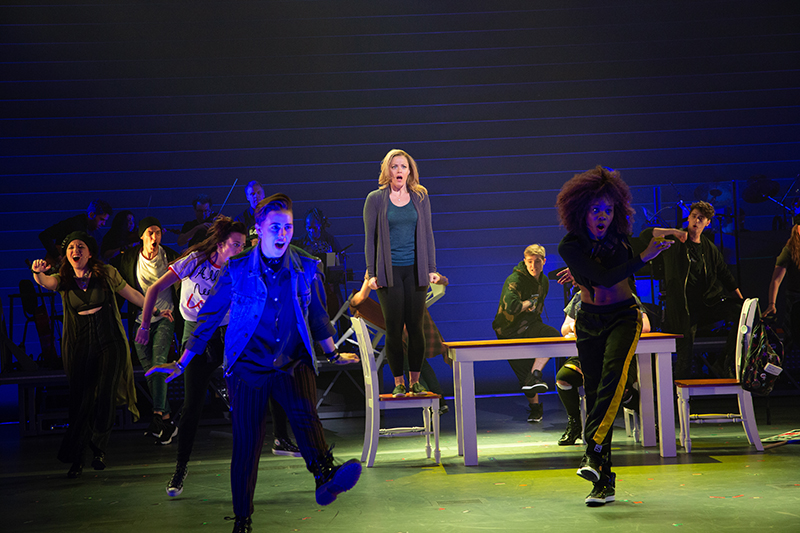
A Ceiling Awash with LEDs
Lighting designer Justin Townsend works on Broadway, off-Broadway and regionally. His Broadway lighting designs include American Psycho, The Humans, Casa Valentina, A Night with Janis Joplin, Vanya and Sonia and Masha and Spike, The Other Place and Bloody Bloody Andrew Jackson, for which he was nominated for an Outer Critics Circle Award and a Henry Hewes Award. In 2016, he was nominated for Tony Awards and Drama Desk Awards for his designs for The Humans and American Psycho. Townsend received an Obie for Sustained Excellence in Lighting Design in 2014 and he is an assistant professor of theatre at Brooklyn College.
“I think there’s a lot of great tools in our industry, and it’s exciting to work with different vendors for different needs, but what I’m excited about with Elation is I think they’re hitting a price point that’s affordable,” says Townsend. “I think their gear is just work-horse, solid and exciting. In an industry where more is more, the dollar just goes further with them.”
Townsend also appreciates the support that he gets from Elation. “They’ve been really kind and interested in making sure I have a chance to try their new tools, that I get to put them into use when I need them,” he says. “They basically asked, ‘How can we help you?’ In fact, I’m working right now with John Dunn and establishing an arrangement at Brooklyn College where my students are able to work with Elation products from the ground up. Also, what I just did with Jagged Little Pill at A.R.T. is a really thrilling thing, using some of the new Artiste Picasso’s. This giant overhead truss structure is completely Elation gear. I’m depending on the ability of this equipment to run a major pre-Broadway tryout production.”
In Jagged Little Pill, scenic designer Ricardo Hernandez designed the overhead V-shaped truss structure over the whole stage, which also houses much of Townsend’s lights. Townsend explains, “That, for me, was the perfect design that worked well lined with LED wash fixtures. We used Elation’s ZW37 because again, the price point’s right, we could rent a lot of them, and the light quality’s right. All of a sudden, it became a ceiling of LED lights. You know, 45, 50 lights that can really create an architecture that the set designer envisioned which then inspired the lighting.”
Townsend found the Artiste Picasso units to “be great. What’s interesting to me about the LED engine versus an arc source, which of course is becoming more and more of a trend with profiles, is that I can depend on the intensity and therefore the light quality to maintain over time. I think their Picasso is a great light, a solid light. We didn’t have any issues with it, and it’s able to replace other units that are arc sources and be day over day brighter. So, a brand-new arc lamp will be brighter than an LED source, but I know that with the Picasso, we aren’t going to be replacing the lamps every three weeks. An LED source is something I can trust as, ‘This is what it is going to be’. I like the LED engine as opposed to an arc source, because I think the CRI has a better range for me, so I’m able to get more warmth; it doesn’t get so green like arc sources can.”
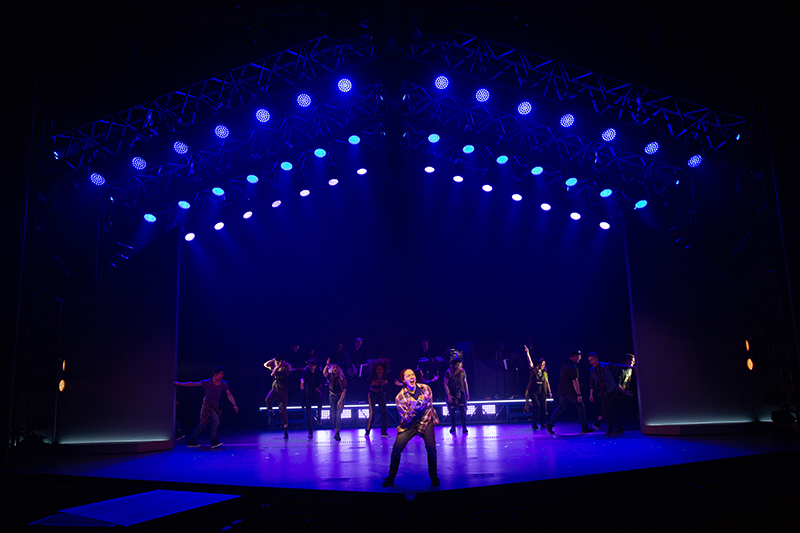
Lighting + Projection = Emotion
Recent theater productions for LD Jason Lyons include the Broadway revival of On the Town, Bring it On: The Musical and Rock of Ages. He designs Off-Broadway and regionally as well. His recent lighting design for Jesus Christ Superstar at Washington, D.C.’s Signature Theatre was honored with a Helen Hayes award. He shared the award with projections designer Zachary Borovay since the lighting and projection design were very much interwoven on this production. Lyons chose to work with the Elation Emotion, a compact digital projector moving head lighting fixture with 4,000 ANSI lumen output and native 1024 x 768 support. It includes an onboard media server with digital gobo and video images, as well as allowing custom content to be easily uploaded.
“From the beginning, we knew that we wanted to create a world of images for Jesus Christ Superstar, especially for the end of the play, that would both overwhelm us and overwhelm the character Jesus,” Lyons explains. “We knew that we wanted images to appear, not just on the set, but also on the actor’s body, as he was going through the final moments in the show. We weren’t sure whether he would be moving around the stage, or whether he was going to be in one place, but we knew we wanted the ability to have articulating images. When I was talking with John Dunn at Elation about it, he brought up the option of using the Emotions. It seemed like the perfect fit, because it was going to allow us to do exactly what we needed; to have the images moving around, but also allow me to use them as moving lights for the rest of the show, which was really great. As we were in a smaller space, in the round, we knew we could use those units really, really effectively.”
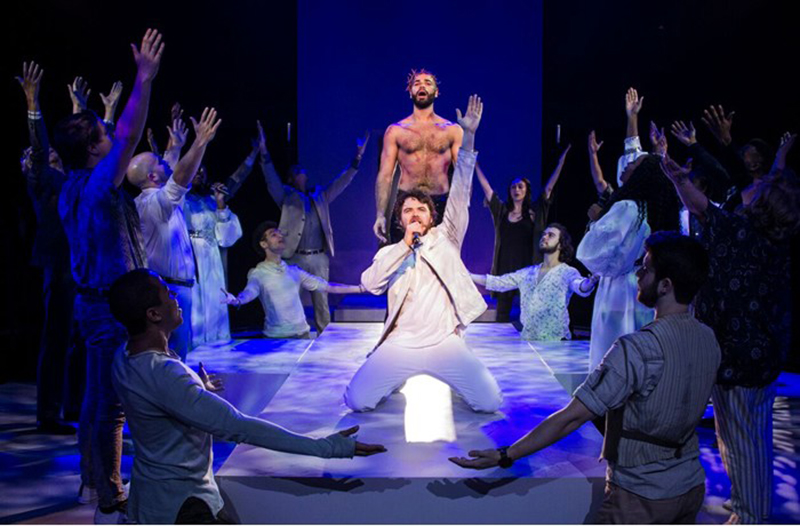
As Lyons worked through the show, he found other moments where the creative team chose to use the Emotions to add video elements into the lights. “We used the Emotions for those times where we wanted to see more than typical movement on people or on the space,” Lyons comments. “We would sometimes focus them to the floor, sometimes the wall, and sometimes the individuals to create some extra kinetic motion. It was like having unlimited gobos; the dream of every designer.”
Lyons appreciates the support that he gets from Elation. “Both Elation and John Dunn have been really great to work with,” says Lyons. He has found lately that new equipment that Elation has been coming out with, “shows that they’re really listening to what we’re looking for as designers in theater,” says Lyons. “I know, in the past, it seemed like they were a little bit more concert-driven in terms of what they’re trying to put out. But talking with them lately, I’ve been very specific about color choices and quality of light, and they’ve really been working pretty hard to meet those requests. They’ve really been able to narrow in a bit and nail both of those needs. I feel really comfortable about being able to spec Elation’s equipment in theater.”
This feature originally appeared in Stage Directions, a publication affiliated with PLSN. Contributor Michael S. Eddy is Stage Directions’ editor-in-chief.
